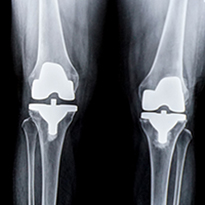
How has knee replacement surgery advanced over the years?
We’ve certainly seen a lot of advancement in total knee replacement surgery (total knee arthroplasty) even over the course of my career. In terms of the materials that the components are made of – they’re much more durable now than they were in the past. I think the surgical techniques have also evolved. We tend to do surgery in a less invasive way now – we try to be less disruptive of the tissue and respect the tissue more. I think the rehab and recovery after surgery has changed quite a bit from having patients in the hospital for days or even a week in the past – to where most of our patients are going home after one night in the hospital and occasionally will do surgery and send patients home the same day. So those are all different areas where the knee replacement surgery has advanced.
Who is an ideal candidate for a knee replacement?
Total knee replacement surgery (TKR surgery) is certainly an option for someone who has extensive arthritis in their knee. As we look at the x-rays we would call this ‘bone-on-bone arthritis’ – where there’s actually no cartilage left in at least one location inside the knee. But at that point, it doesn’t really mean that that person must have surgery. Because the reason for doing surgery is not only determining if the patient is a candidate for a knee replacement (knee arthroplasty) because of their bone-on-bone arthritis, but it is also determining if the patient is able to do the things that they want to do and if they are able to get relief for the pain. If the patient can still manage the pain, even with the arthritis, there is no urgency in doing the surgery. We can always do the surgery later if the patient decides to do that and we can expect basically as good an outcome. So, you really don’t jeopardize anything by waiting. But if you are at that point where you’re not able to do those things that you want to do, then that may be the time where you want to go ahead and look into that option of having the knee replacement.
What does the total knee replacement surgery entail?
I always think of a knee replacement as more of a resurfacing that a replacement. If we do a hip replacement, for instance, it’s truly a replacement. We’re putting a whole new ball in the hip and a whole new socket. But in a knee replacement, we’re only replacing the bearing surface (the cartilage) with a different surface. So that’s why would call it a resurfacing. The procedure still relies on all the ligaments, tendons and the soft tissues to hold everything together – just like the native knee is held together. There’s no mechanical linkage. There’s no hinge. If you look at what comes out when we do surgery, it basically looks like some shavings of bones that we trimmed off the ends of the thigh bone and the shin bone. Really that’s what it comes down to. It may be simpler than you think because in the end, you have metal rubbing on plastic, in most replacements, and you can’t feel that. Bone rubbing on bone causes pain and it really is that simple.
What does the recovery process involve after a knee replacement?
The recovery after knee replacement is much more accelerated now than it used to be. We’ve learned that it’s important to get people up and moving as soon as possible. It’s not only better for them in general for their health after surgery, but also better for the knee. Patients tend to do better if you get the knee moving before the chance for the swelling and stiffness to set in. So again, the time in the hospital has decreased significantly over the years. We do the physical therapy really the day of surgery – as soon as patients are back in their room, we’ll have them up full weight bearing starting to walk around the room using a walker, starting to work on moving that knee. It’s a much more accelerated program. We try and get people back up and moving more quickly than was done in the past.
